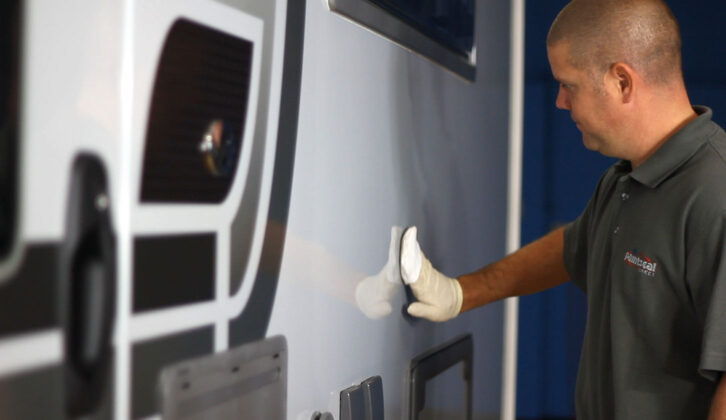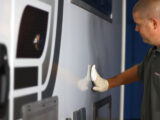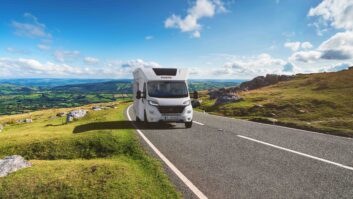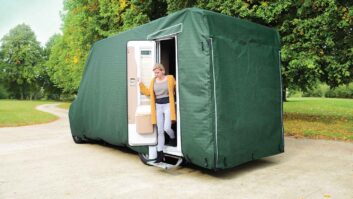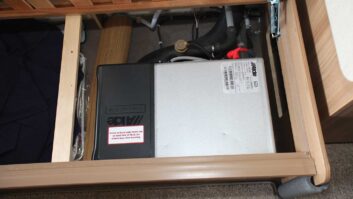Whether you have one of the best motorhomes that is fresh off the production line or have a ‘van that has a few miles under its belt, it makes sense to protect such a valuable asset the best way you can against the constant attack of road film, tree sap, dead bugs, acid rain, road salt and exhaust particulates. This is where motorhome paintwork protectors come in.
This involves applying a ceramic paint-protectant solution on the exterior panels. You can also guard interior furnishings against spills and stains with a spray-on protector.
These safeguarding solutions provide an invisible shield for your vehicle’s surfaces, resisting dirt, grime and stains, and protecting against discoloration.
Protectants have been around for a long time. Originally, they were wax based, then super-slippery PTFE (often branded as Teflon); but these days, the best are ceramic, an indiscernible layer of liquid glass, which contaminants sit on, making them easier to rinse off.
If you’re also thinking of giving your ‘van a thorough clean, our best motorhome cleaner guide is worth a look, as we share our pick of the products that will effortlessly spruce your van up!
How motorhome paintwork protectors work
The theory is that while your ’van’s exterior might look perfectly smooth, at a microscopic level, it’s actually about as uneven as the Himalayas.
Minute particles of pollution and dirt, anything from diesel exhaust particulates to road muck, become lodged in this coarse micro-surface, eventually leading to a loss of shine, discoloration and deterioration of the surface material.
The protectants aim to fill those indentations and undulations, so a surface that was all peaks and troughs is afterwards much smoother, shinier and level. This makes it far harder for dirt to become ingrained in it, so it’s easier to keep clean.
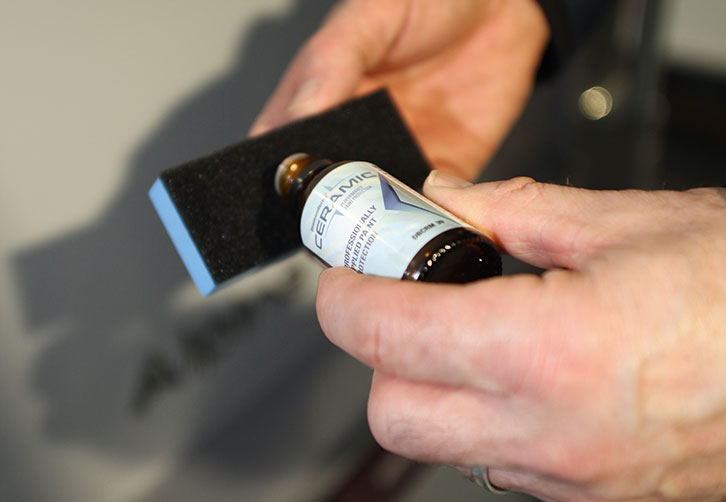
Likewise, PTFE solutions sprayed on carpets and furnishings create a tough, slippery coating that contaminants can’t penetrate. Liquids or solids, anything from red wine to mud off your pet’s paws if you’re touring with pets, will sit on top of the coating and wipe off with minimal effort. Without it, contaminants could sink permanently into the fabric.
The benefits of a protective coating
With rigorous washing, polishing and elbow grease, you might be able to remove almost all micro-contaminants manually, but, seriously, who has the time for that? If you’re cleaning a motorhome, a thorough exterior clean takes at least half a day!
With a professionally applied ceramic finish, rainwater will simply run off all of the vehicle’s wall panels, while any contaminants in water sitting on the roof won’t penetrate the surface.
Dirt that splashes onto your panels will rinse off easily, and if there are any more stubborn black streaks from the window rubbers, these should simply wipe off, using the cleaning agents supplied by the protectant makers.
We’ve all tried rubbing away those obstinate black streaks on our ’vans, and yes, detergents can help, but the scouring action can damage and age the surface of the panel, and leave
it more prone to chalking (drying out and becoming dusty). Luckily, the latest protectants solve all of these problems.
Another potential bonus is that paying for ceramic protection also says something about you as a motorhome owner. It implies that you care about the things you own – which has to be worth a few quid on the residual value. Seen this way, paying to protect your vehicle is simply an investment that may well pay back later, when you come to sell it on.
Several brands offer leisure vehicle protectants, and two of the biggest are Paintseal and Diamondbrite. Here, we take a look at both companies, and find out what they offer to customers and their motorhomes.
Diamondbrite
Diamondbrite Ceramic is an ultra-hard, high-gloss protectant, guaranteed against paint fading, deterioration of the gloss finish and even bird muck, so long as it’s removed as soon as possible (terms and conditions apply). “Once applied, you will never have to polish your vehicle again,” claims marketing director Lance Boseley.
Diamondbrite is a two-stage process. Stage One fills the pores in the panel surface, then Stage Two adds a hard protective shell in a high-lustre finish.
Diamondbrite recommends treating your protected vehicle with its special Conserver product every one to three months, depending on the miles you cover. This will help to preserve the protection that Diamondbrite offers.
To maintain your guarantee, you will also need to register your Diamondbrite treatment within 14 days of application.
Find out more at diamondbrite.co.uk
Paintseal
Paintseal’s protector is a liquid-glass ceramic coating called Gen-3.
It is only applied by the company’s own specialist technicians, and a single application is guaranteed for five years on new vehicles and for three years on vehicles over six months old (because they are likely to have already been waxed or shampooed).
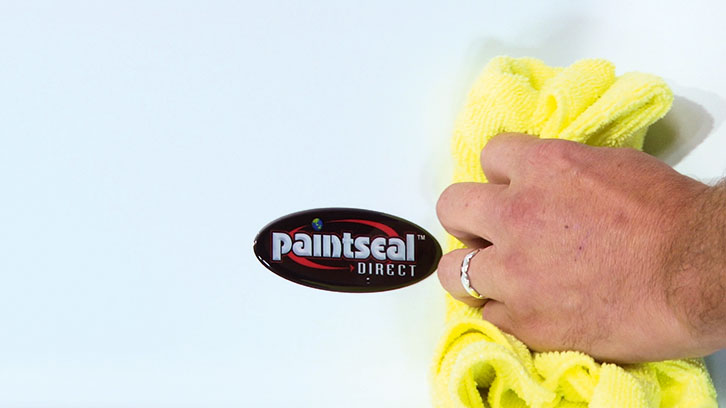
In reality, Paintseal says it should last much longer, and doesn’t require topping up or conserver treatments.
“If any customer ever does have a problem, we’ll inspect the vehicle and correct any issues as appropriate,” says Lisa Bradbury, co-founder and owner of Paintseal.
Paintseal’s Ceramic Glasscoat is a polysiloxane, which provides excellent weathering attributes (so it will retain its shine for longer) and offers good resistance to UV rays and heat.
It also displays exceptional resistance to abrasion, corrosion and chemical attack, minimising dirt pick-up.
“We do apply Gen-3 to wheels, but we don’t put it on acrylic windows,” says Lisa. “We’ve lived and breathed paint protection for 35 years, so we really know what works.”
To protect the upholstery fabrics, furnishings and carpets fitted inside your motorhome, Paintseal uses a specialist spray-on, hypoallergenic, non-CFC, PTFE formula product.
Find out more at paintsealdirect.com – you can also see how Nigel Hutson got on when he went behind the scenes at Paintseal Direct too.
How much should I expect to pay to have a paintwork protector applied to my motorhome?
A complete Paintseal Ceramic Gen-3 treatment (Glasscoat exterior and Teflon interior) costs £599 for a 6.3m motorhome, to £899 for a 9.1m ’van (price on application for vehicles longer than this). The carpet protection treatment is £50 extra.
Prices for Diamondbrite treatments vary, depending on the technicians that you use to apply them.
Both companies also provide free aftercare packs, including specialist products to clean and protect their ceramic finishes.
How a protective coating is applied to a motorhome
These protectants have to be applied meticulously, similarly to the way you might polish your motorhome, but with extra attention to detail, so that not a single square centimetre is missed.
Paintseal has a team of expert technicians around the country, who travel to dealers or the owner’s home or storage facility to apply the solution.
“Our staff are all in uniform and work exclusively for Paintseal,” says owner Lisa Bradbury. “Applying our product is what they do every single day, so they are expert at it.
“Some people want to see Paintseal being applied to their vehicle, so if that’s the case, they can come to our premises in Nottingham, where we have a specialist facility just for the task. Alternatively, they can drop their vehicle off and take a courtesy car to explore the area, while the work is being done.”
Diamondbrite takes a slightly different approach, training staff at its partner dealerships in the application process. That said, both products follow a similar method to guarantee 100% coverage of the exterior panels.
One thing that anyone applying these solutions definitely needs is a patient disposition, because the coverage must be absolutely meticulous.
I recently visited the team at Downtide Caravans & Leisure, in Norfolk, to see how it’s done. Staffer Jake was clearly exactly the right person for the job, giving the task his complete concentration and ensuring that every square centimetre (and there are a lot) of each vast panel was coated in the Diamondbrite potion.
The process for both products involves cleaning/dewaxing the panels, and then carefully coating each one.
The solutions are almost invisible once applied, so this is done section by section, to ensure no area is missed.
Typically, a section will be three to four feet wide and half the depth of the panel, although it’s easiest to use the windows, doors and decals as obvious and visible location points to distinguish the edge of each section being worked on.
Thanks to Downtide Caravans & Leisure in Norwich, Norfolk, for help in demonstrating the treatments.
- Take a look at our motorhome fuel consumption guide to find out the steps you can take to help you save both time and money.
If you’ve enjoyed reading this article, why not get the latest news, reviews and features delivered direct to your door or inbox every month. Take advantage of our brilliant Practical Motorhome magazine SUBSCRIBERS’ OFFER and SIGN UP TO OUR NEWSLETTER for regular weekly updates on all things motorhome related.
